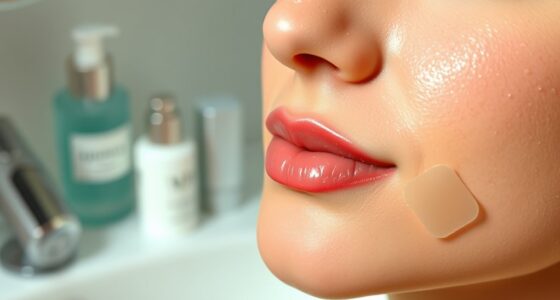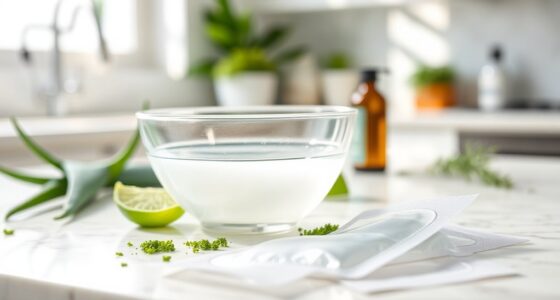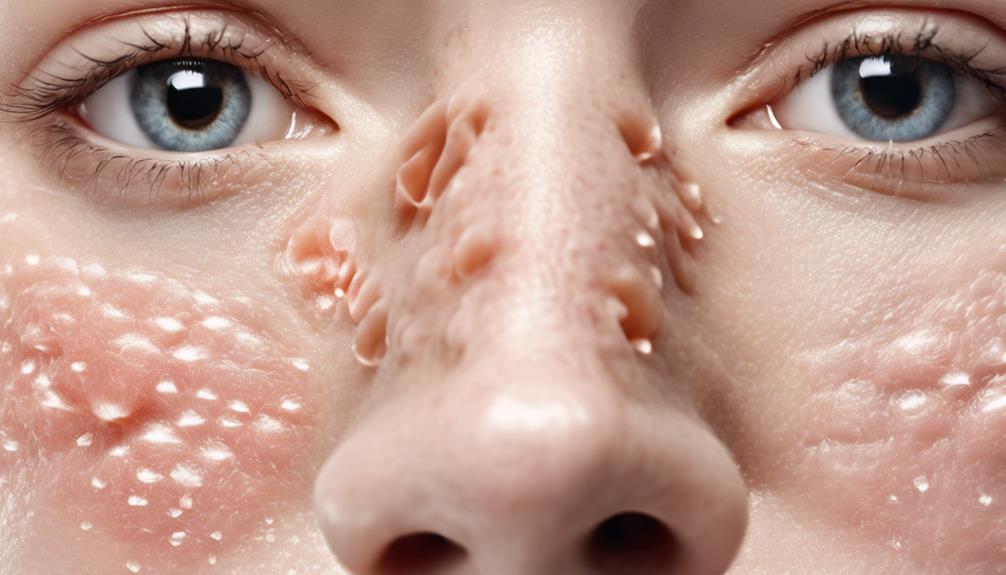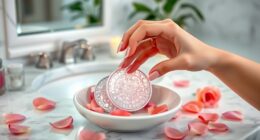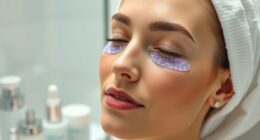Yes, pimple patches can work on hormonal acne! They reduce inflammation and promote faster healing by providing a moist environment while containing active ingredients like salicylic acid and tea tree oil. Hydrocolloid patches are great for surface blemishes, while microdart patches can penetrate deeper for cystic acne. However, it's crucial to incorporate them into a broader skincare routine for the best results. Want to know more about how to maximize their effectiveness?
Key Takeaways
- Pimple patches can effectively reduce inflammation and promote healing in hormonal acne by creating a moist environment and absorbing excess fluid.
- Active ingredients like salicylic acid and tea tree oil in pimple patches target acne-causing bacteria and unclog pores.
- Hydrocolloid patches are suitable for raised pimples, while microdart patches may provide enhanced effectiveness for cystic hormonal acne.
- While pimple patches help with active breakouts, they should be part of a broader skincare routine addressing underlying hormonal issues.
- Stress and dietary factors can exacerbate hormonal acne, so managing these aspects is crucial alongside using pimple patches.
Understanding Hormonal Acne

Hormonal acne occurs when fluctuations in your hormones, especially androgens, trigger excess sebum production, leading to clogged pores.
You might notice deep cystic lesions forming along your jawline, chin, and cheeks, often during menstrual cycles or significant hormonal changes.
Unlike other acne types, hormonal acne tends to be persistent and may require systemic treatments like hormonal contraceptives or anti-androgens, such as spironolactone, to help regulate your hormone levels.
Hormonal acne is often persistent, requiring treatments like hormonal contraceptives or anti-androgens to regulate hormone levels.
Stress can worsen hormonal acne too, as increased cortisol levels stimulate oil production and inflammation in your skin.
Additionally, dietary factors, like high glycemic index foods and dairy, can influence your insulin and androgen levels, potentially exacerbating your hormonal acne. Essential oils can also play a role in skin health, with certain oils like lavender offering potential benefits for calming inflammation.
How Pimple Patches Work

Pimple patches are innovative tools designed to tackle breakouts effectively.
These hydrocolloid patches create a moist healing environment by absorbing excess fluid and pus from pimples, which helps reduce inflammation and promotes fast healing. They form a protective barrier over your blemish, preventing external irritants and bacteria from entering, while also minimizing the urge to pick at it.
For hormonal acne, you can enhance their effectiveness by incorporating active ingredients, like salicylic acid, into your skincare routine. Microdart patches can deliver these ingredients directly into the skin, targeting the root cause of breakouts. Additionally, using products with glycolic acid can help improve overall skin texture and tone, further supporting the healing process.
Apply pimple patches on clean, dry skin and leave them on for several hours or overnight to maximize their benefits.
Active Ingredients in Pimple Patches

Effective pimple patches often incorporate a variety of active ingredients tailored to combat hormonal acne. Salicylic acid plays a key role by unclogging pores and reducing inflammation associated with breakouts.
You'll also find tea tree oil in many patches; its antibacterial properties effectively target bacteria that can worsen hormonal acne. Another beneficial ingredient is niacinamide, which helps improve skin tone and texture while stabilizing your skin barrier.
For added hydration, some pimple patches include hyaluronic acid, preventing dryness and irritation from other active ingredients. Additionally, patches designed for cystic acne treatment may provide enhanced efficacy for those struggling with more severe hormonal breakouts.
Types of Pimple Patches

When it comes to treating hormonal acne, understanding the types of pimple patches available can make a significant difference in your skincare routine.
- Hydrocolloid patches: Best for raised pimples, they absorb excess fluid and create a moist environment that aids in healing.
- Microdart patches: Contain tiny dissolving needles that deliver active ingredients like salicylic acid directly into the skin, effectively targeting inflamed hormonal acne.
- Hero Cosmetics Mighty Patch: A popular hydrocolloid option that's great for quick relief.
- Rael Microneedle Technology Acne Healing Patch: Utilizes advanced delivery systems for effective treatment.
Additionally, keeping your environment in mind, air quality considerations can also play a role in how your skin reacts to acne treatments.
Effectiveness of Pimple Patches for Hormonal Acne
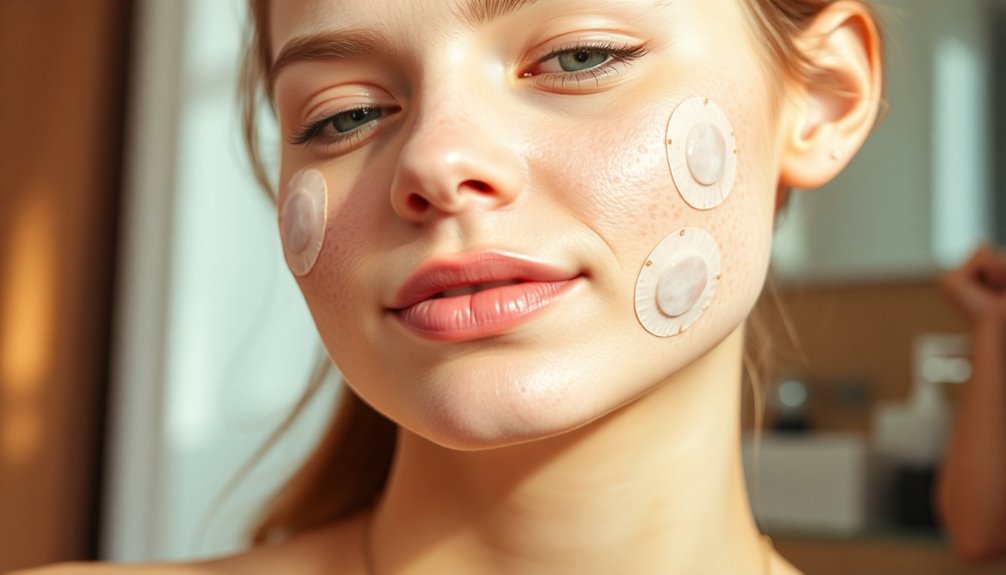
While you might be frustrated with hormonal acne, pimple patches can offer a targeted solution to help reduce inflammation and promote healing.
These patches often contain acne-fighting ingredients like salicylic acid and tea tree oil, which work to unclog pores and calm angry breakouts. Hydrocolloid patches create a moist healing environment that prevents picking and irritation, supporting the healing process.
For more advanced treatment, microdart patches deliver active ingredients directly into the skin, potentially enhancing results for cystic and hormonal acne.
While pimple patches can effectively reduce the size and inflammation of your breakouts, they should be used as part of a broader skincare routine that addresses underlying hormonal issues for the best results. Additionally, maintaining a balance between spiritual and physical energy can contribute to overall well-being, which may positively influence skin health.
Tips for Using Pimple Patches on Hormonal Breakouts

Pimple patches can be a game-changer for tackling hormonal breakouts, but knowing how to use them effectively makes all the difference. Here are some tips to maximize their effectiveness:
- Apply pimple patches on freshly cleansed, dry skin for best results.
- Choose patches with active ingredients like salicylic acid and niacinamide to reduce inflammation and speed healing.
- Leave the patches on for 6-8 hours to absorb excess fluid and enhance their impact.
- Incorporate a skincare routine that includes retinol and niacinamide to manage hormonal acne and prevent future breakouts.
- Staying hydrated is also crucial as it helps maintain skin hydration and promotes overall skin health, which can reduce the severity of breakouts.
If your breakouts are severe or persistent, consult a dermatologist for additional treatments.
With these strategies, you can effectively use pimple patches to combat hormonal acne.
Frequently Asked Questions
What Is the Best Acne Treatment for Hormonal Acne?
When tackling hormonal acne, you've got several options to evaluate.
Systemic therapies like antibiotics or birth control can help regulate your hormones. Spironolactone's also a great choice to reduce oil production.
For topical treatments, look into acne patches that contain soothing ingredients like tea tree oil.
And don't forget about microneedle patches that enhance ingredient absorption.
If your acne's severe, it's wise to consult a dermatologist for personalized advice.
When Should You Not Use Acne Patches?
Sometimes, it's best to let your skin breathe instead of slapping on those acne patches.
You shouldn't use them on uninflamed areas or skin without active pimples, as they can cause unnecessary irritation.
If you have sensitive skin, steer clear of these patches altogether; irritation and allergic reactions aren't worth the risk.
What Type of Acne Do Pimple Patches Work On?
Pimple patches work best on raised pimples with visible pus, such as those from cystic acne. They absorb fluid and create a moist healing environment, speeding up recovery.
Hydrocolloid patches can reduce inflammation, making them effective for inflamed breakouts. If you're dealing with newly formed pimples from hormonal changes, these patches can provide relief.
However, they're not designed for clogged pores or blackheads, so keep that in mind when selecting your treatment.
Is It Okay to Put Pimple Patches on Cystic Acne?
Absolutely, you can put pimple patches on cystic acne! Imagine a tiny superhero swooping in to fight those deep, stubborn blemishes.
While they won't completely erase the cysts, they can help reduce inflammation and protect your skin from picking.
Just remember to apply them on clean, dry skin and leave them on for several hours or overnight.
Consistent use can make a noticeable difference, but don't forget to consult a dermatologist for severe cases!
Conclusion
In the battle against hormonal acne, pimple patches can be your secret weapon. While they might not be a magic bullet, their ability to absorb impurities and create a protective barrier makes them a valuable ally. When used correctly, they can help speed up healing and reduce inflammation. So, next time a hormonal breakout strikes, don't hesitate to reach for those patches—they just might turn your skin woes into a distant memory!



